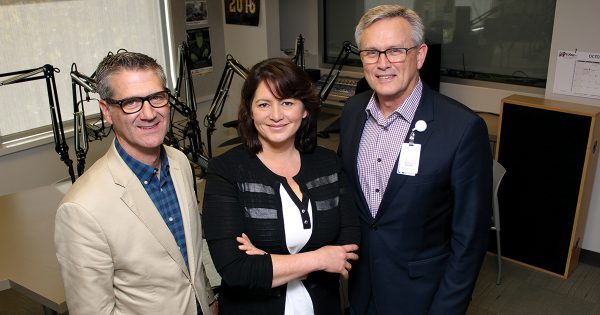Healthcare executives talk telemedicine, other issues in roundtable discussion
by November 28, 2018 10:03 am 697 views

Telemedicine and virtual healthcare are the most important technology innovations right now disrupting the healthcare industry.
That was one takeaway from a group of executives who gathered recently for a roundtable discussion in the Firmin-Garner Performance Studio at Fayetteville radio station KUAF 91.3 FM. Included in the conversation were:
· Dr. Steve Goss has served as president of Mercy Clinics Northwest Arkansas since 2003, working with over 80 multispecialty physicians at 22 clinic locations throughout the region.
· Dr. Pearl McElfish joined the University of Arkansas for Medical Sciences (UAMS) in 2010, and she was promoted in October to vice chancellor of the UAMS Northwest Arkansas regional campus in Fayetteville.
· Dr. Robert Steele is a pediatrician who joined Arkansas Children’s in June 2014 as the senior vice president/chief strategy officer.

Steele said the practice of telemedicine was met initially with some hesitancy. He said there is still a steep learning curve, but physicians are largely embracing the broad range of technologies and services to provide patient care and improve the healthcare delivery system as a whole.
“I think that the culture aspects of how to do that, what it means to do that, what it takes to do that and how that works within the workflows of actually seeing patients, there’s still a lot of learning in that,” he said. “But I would say overall it’s a pretty exciting time.”
McElfish, said new UAMS Chancellor Cam Patterson is a leader in the field of virtual medicine and virtual health, an area of healthcare that is expanding quickly.
“We’ve looked at it from a cost-savings perspective,” she said. “But really from a patient-care perspective, when you’re in a rural state like Arkansas, if you are taking your mother to UAMS in Little Rock or Mercy in Rogers for a complex surgery, but you live in let’s say Harrison or Mountain View, the ability to have that follow-up appointment virtually really takes [out] so much cost and difficulty for the patient.”
Goss said access and convenience now demanded from society is something that medicine is trying to adjust to, especially when it comes to demographics that include the aging Baby Boomer population and their Millennial children.
“The aging population is an interesting topic because one of the tools that Mercy’s developed is what we call “VE,” as in ‘virtual engagement,’” he said. “A lot of people have had experience with what we call an EICU where ICU beds are monitored centrally somewhere else, and you’ve got to get a layer of intensive care nursing and critical care specialists that are able to look over the shoulder, virtually, if you will, of the bedside caregivers.”
The three healthcare executives shared their thoughts on a number of additional topics including strategies for physician recruitment and retention, expanded residency training, the impact of design and technology in the construction of new facilities and the policy debate on pre-existing conditions.
You can listen to their full conversation below.
.
